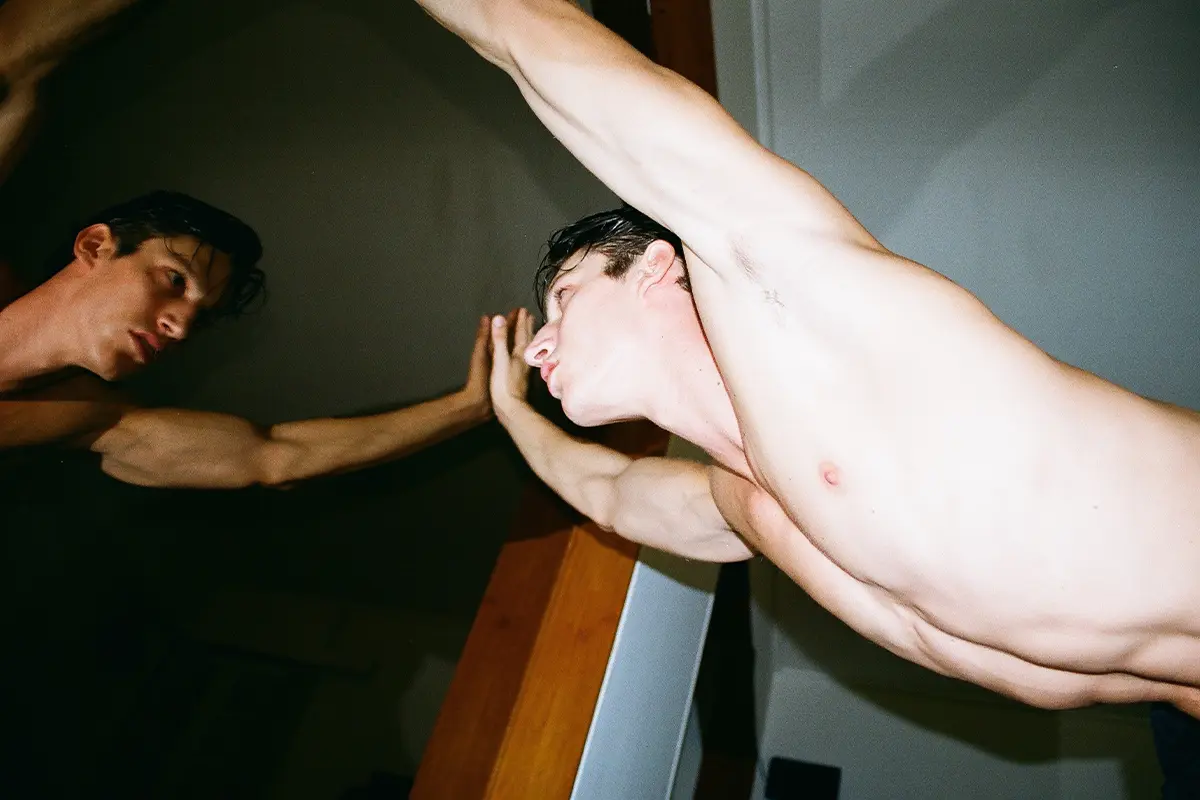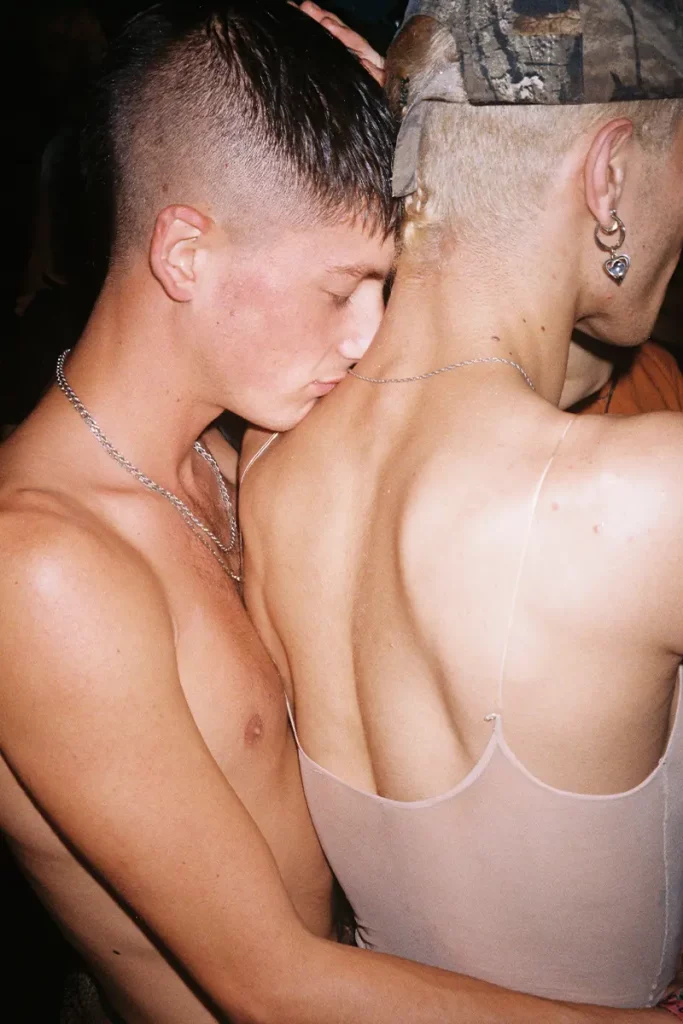Exploring life, documenting intimacy and shaking emotions: a journey through Corporeal, the latest book by Greek photographer Spyros Rennt
Beauty is in the impulse: Apollonian and Dionysian spirit – inspiration behind Spyros Rennt’s Corporeal
‘Kalòs kai agathòs‘, literally ‘the beautiful and the good’ has its origins in Greek culture. It stands for the beauty of the harmony between body and soul, between outer and inner qualities. It is a notion that subsequently comes to life in Spyros Rennt’s work. The pursuit of the Greek ideal, influenced by the theories of Polyclitus in mid-fifth century BC. and Pythagorean ideas, evolved into a harmonious aesthetic emphasizing proportion and naturalness. Perfection was never found in a single human being and, as a result, sculptures with exemplary bodies emerged. Similar to deities, imperturbable in gaze, able to dominate the passions of the body through the soul.
The Birth of Tragedy: Friedrich Nietzsche
This synthesis coincided with what was later, in the modern age, defined by Friedrich Nietzsche as the ‘Apollonian spirit’. Apollo, in fact, represented koûros, ‘the young man’ with a perfect body and embodied balanced and rational beauty. He sat at the opposite end of Dionysus, god of wine and mystical ecstasy, at the table of Olympus. It is not only the Apollonian spirit that shapes the ‘beautiful’ corporeality.
Apollonian beauty represents composure and harmony but the Dionysian principle is described differently by Nietzsche. In The Birth of Tragedy, he defines it as that which rips through the principium individuationis to release the dancing flow of formless life. The Dionysian spirit is fundamental to the human representation of beauty, understood as truth drawn from the nature of things. As a result, the Dionysian impulse bursts beneath the surface of the body like «an ecstatic rapture rises from the intimate depths of man of nature» – Nietzshe.
Corporeal: a visual diary by Spyros Rennt
The same vital energy flows from the bodies seen through the lens of Spyros Rennt in his latest volume Corporeal. It includes vibrant images as if they shake the printed paper and, seducing him, suck in the viewer. The photographer of Greek origin, transplanted to Berlin, awakens the human essence in us with his eye. The talking photographs tell us mostly about a true rave subculture, nightlife and queer lifestyle. People and contexts that do not shy away from the truth: Corporeal is a diary of being that, just as in written confidences, even the deepest, sentimental and sexual emotions are confessed, as it reveals the essences and voluptuousness of its protagonists.
Free your body: a tale about intimacy
Nudity is a means of getting to the essence of things, a way to tell the story of intimacy without frills. «Less is more» is a winning rule at this juncture. We are in an age where the focus on clothing is undergirded by the need to give voice to one’s personality. By removing a layer, you get to your most authentic and personal shell: one’s skin. Nothing is more fashionable than free your nipple or your dick or any other body part. The naked body is a hymn to equality in differences, a sense of self-knowledge and acceptance.
In Spyros Rennt’s work it seems that a naked body is a return to primordiality. A state of being that is pure and sincere, an altruistic and communal gesture to undress and give oneself over to the looks or touch of others. The vibrant connection that Rennt manages to create between the photographed bodies and that of the viewer is a play of invisible yet crushing threads. It is an immediate awakening of desire that leaves a taste of honey on the lips even when it is not spring.
Spyros Rennt: Nudity versus pornography
Lack of clothing and showing one’s physicality in works of art may fall under the definition of pornography. As ‘the explicit depiction of erotic and sexual subjects carried out in various forms‘ – however, nudity does not necessarily correspond with pornography in the erotic sense.
In Corporeal, Spyros Rennt’s research does not focus only on this one aspect. Images that can be identified as pornographic «are only one of the various aspects of the scenes I capture and have not been a big focus of my practice in recent years». What is a fixed point in the photographer’s poetics is intimacy, «and I think that this is possible even if there’s nudity in an image», says Rennt.
Feel the music. Step into a scene of playfulness and honesty
Other ingredients of Spyros Rennt’s photographic work are playfulness and a sense of honesty. It is through the ability to immobilize these elements that the viewers can step into the scene. They can appreciate it as if they were part of the action themselves. The moving perception of the frames also carries with it all the contextual sensations: the musicality of night clubs, the sense of heat, the desire to venture a provocative glance, the need to dance, can be felt.
Sensuality beyond physicality: extracorporeal
The inclusiveness of the subjects photographed suggests a discovery of ‘beauty’ everywhere. Water can be sexy, as well as a fruit or people fucking or a barely noticeable gesture that vibrates the hair of an arm. The broad spectrum of various dynamics that Rennt photographs shows that sensuality can be found in any situation: «She drove with the throttle to the floor and took the curves sliding and screeching and without expression. That was class. If she loved like she drove it was going to be a hell of a night». wrote Charles Bukowski.
If the focus of Rennt’s work is on the corporeal, what it triggers is an extra-bodily energy. A balance of controlled and unbridled eroticism. The way Rennt understands sensuality, «it’s more about igniting desire and teasing the imagination».
The body as revealed by Spyros Rennt: new territories to explore
In some images Rennt reveals bodies as natural landscapes. The contortionist forms they take highlight the possibilities as far as we can push our boundaries. Some bodies seem perfectly structured and harmonious, caught in a moment of tension. All the anatomical details are warm and in action: the essence of the discobolus of Myron today.
Other figures are folded in on themselves, losing their canonical features and shaping new geographies of physicality. Backs become shifting dunes under hands now stronger and gentler. Butts are mountains to be climbed, legs are peninsulas between which a fjord made of new desires dawns.
Group dynamics are moments of a safari where felids meet and collide in bodily assemblages. Choreographies of interlocking physiques evoke passion, strength, domination, submission, belonging or love.
Whatever the combinations, Rennt’s bodies attract like magnets. And bodies are followed by natural instincts. In the 1973 film, La maman et la putain, directed by Jean Eustache, a sweet truth was heard. «It’s nice to sleep feeling a cock, even soft, against your ass».
Bodies transcending gender
«I think that all bodies are fascinating from a photographic perspective» attests Rennt. His exploration of human bodies in Corporeal is pushed beyond all boundaries. It crosses the limit of what might have seemed most comfortable to him before: the male body. In his latest work photography has expanded to observe and document all facets of bodies, transcending gender.
Historically, as early as prehistory, visual culture in male and female bodies unearthed allegories of robustness or abundance. It carried on in the collective imagination of the recent past: «Our Greek or Latin soil, sustained everywhere by the framework of rocks, has the forthright elegance of a manly body: the Scythian earth had the somewhat coarse opulence of a woman’s upturned body», Marguerite Yourcenar has her emperor say in the book Memoirs of Hadrian.
Today, the gaze on male and female anatomies rests with more flexibility to the point of perceiving how each human being offers the uniqueness of the bodily spaces he inhabits, as Rennt reveals.
Voyeurs with permission: the role of the spectator
In the gestural vocabulary presented on the last page of the book, there is an outstretched hand. It is an invitation to grasp it and to let the observer participate in the banquet of sensations.
Rennt is the first spectator who breaches the private life of the book’s protagonists. He does it by building «a relationship and a rapport with them». Documenting is an intimate and gentle practice that requires softness with people. It is an exchange of trust.
Corporeal reveals a non-intrusive photography. It seems to insert itself between the realities of the subjects and their actions and emotions without disturbing. Just as Degas looked through the keyhole without altering the harmonies of a dance, Rennt does not sweeten the harmonies of bodies immersed in life.
Spyros Rennt
Spyros Rennt is a photographer and artist living in Berlin, originally from Athens. He is known for documenting an authentic life, especially queer. He has published two photographic books, Another Excess (2018) and Lust Surrender (2020) as well as multiple zines. Corporeal is Rennt’s third self-published book.




















